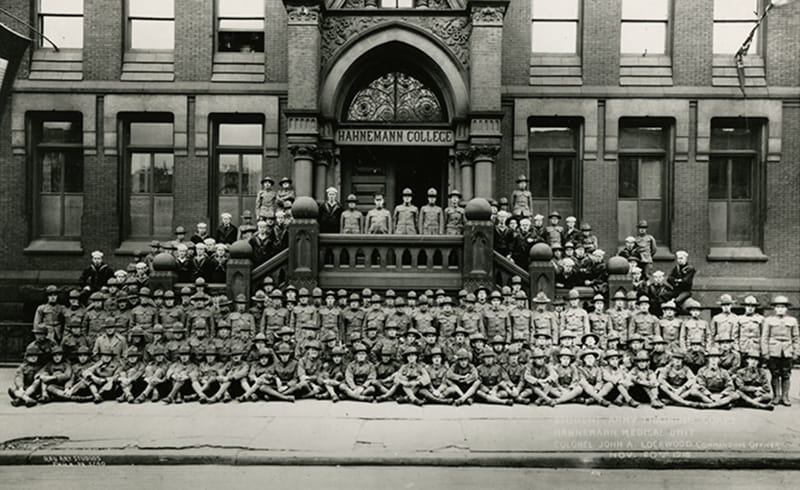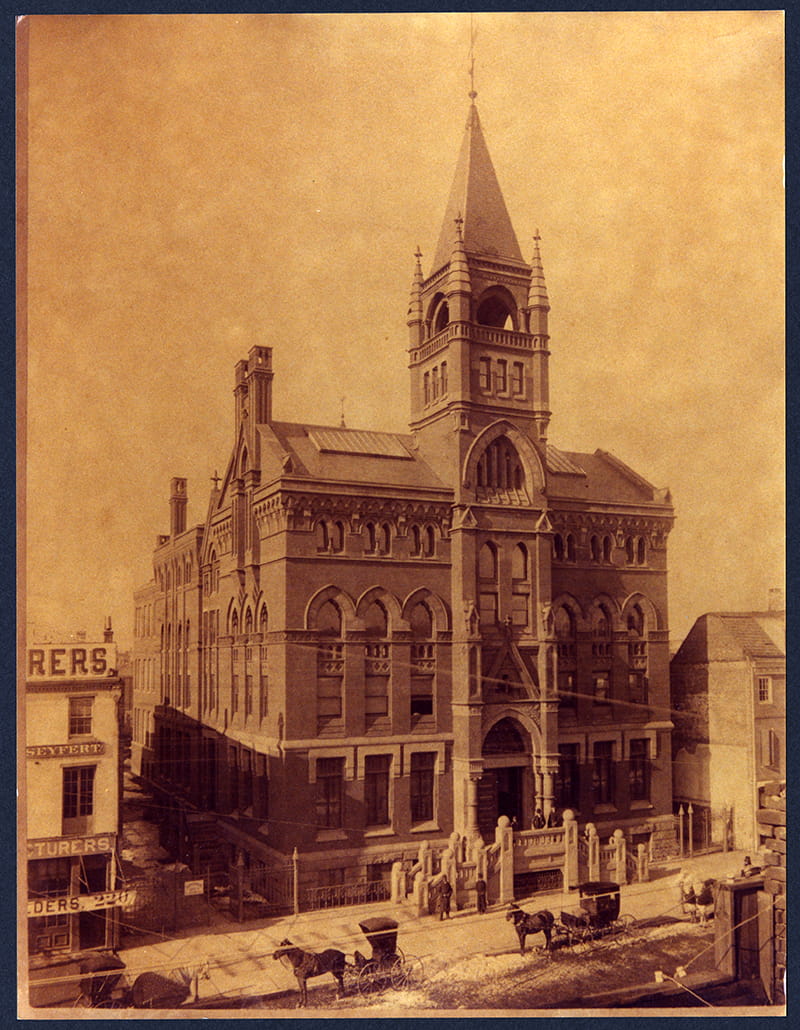An Exhibit Epitaph Honoring 171 Years of Hahnemann History

The bankruptcy and closure of Hahnemann University Hospital over the summer marked an abrupt end to a 171-year-old legacy known for path-making medical firsts in the fields of homeopathy, anatomy and cardiology, as well as its progressive medical education and exceptional medical care provided to its patients.
Those significant aspects of Hahnemann’s outstanding and distinguished history are explored in The Drexel Collection’s newest exhibit, Honoring the Hahnemann Community. It will be held through Jan. 10 in the Paul Peck Alumni Center, and will also be displayed on the Center City Campus and Queen Lane Campus at later dates.
The exhibit documents the history of the institution through an extensive timeline, historical objects and a wide array of archival photographs from the Legacy Center Archives in Drexel University’s College of Medicine. And in honoring the hospital, as the name suggests, the exhibit recognizes the faculty, staff, students, alumni and community that supported and benefitted from the institution for generations.
The Hahnemann University Hospital that closed in 2019 had a different name, location and medical focus than what it had started as 171 years prior. Its roots can be traced to the Homeopathic Medical College of Pennsylvania, which opened in 1848 at 627 Arch St. to teach a new medical system known as homeopathy, which promoted the belief that a substance that produces symptoms in a healthy person can also be used to treat disease causing similar symptoms in a sick person. It also operated a free clinic to the sick, providing clinical opportunities for its students.

Homeopathy, which was created by German physician Samuel Hahnemann, was very popular in the 19th century. The medical school, which changed its name to Hahnemann Medical College of Philadelphia in 1869, was the first enduring institution to teach it. But by the middle of the 20th century, the field of homeopathy declined and Hahnemann accordingly rearranged its curriculum, having stopped requiring homeopathy courses in 1945 and removing them entirely in 1959.
By that time, Hahnemann had already started re-inventing itself as a nationally known academic medical center with prominence in cardiac surgery, cardiology and oncology. It would go on to become a leader in organ transplantation and the training of non-physician health professionals. That means that throughout its complex 171-year-old history, Hahnemann was well-known for its innovative staff and offerings, which is why it was home to some of the first medical procedures and offerings in the area, region and world.
A timeline of those “firsts” include:
- 1889: Rufus B. Weaver, MD, a professor of anatomy at Hahnemann Medical College, unveils the world’s first complete nervous system teaching specimen, dissected from a person thought to be named Harriet Cole.
- 1920: Hahnemann opens America’s first school of X-ray technology.
- 1928: Hahnemann University Hospital, located at 230 N. Broad St., opens its doors. At 20 stories high, it is the country’s first “skyscraper” hospital.
- 1948: Chief of Thoracic Surgery Charles P. Bailey, MD ’32, performs the world’s first successful closed-heart valvular surgery. He appears on the cover of Time magazine in 1957 in recognition of his work in cardiac surgery.
- 1963: Hahnemann doctors perform the region’s first kidney transplant.
- 1967: Hahnemann starts the world’s first graduate-level art therapy education program.
- 1970: Pennsylvania’s first outpatient dialysis unit launches.
- 1971: The region’s first Physician Assistant program is created.
- 1976: Hahnemann doctors perform the region’s first allogeneic bone marrow transplant in 1976.
- 1986: Hahnemann opens Philadelphia’s first Level 1 Trauma Center for adults.
This commitment to exploring and developing new medical techniques and fields lasted until the very end: in 2017, Hahnemann became the country’s second academic medical center to offer a transgender surgery fellowship training program.
Throughout the years, patients benefited from these programs and techniques, as well as the care of Hahnemann professionals. As a safety-net hospital, Hahnemann provided affordable care to Philadelphia’s uninsured, undocumented and vulnerable residents, as well as those living in the neighborhoods north of City Hall. The hospital also had its fair share of notable patients: actress and future Princess of Monaco Grace Kelly was born at Hahnemann in 1929; supermodel Gia Carangi died there of AIDS-related complications in 1986; Vanguard founder John Bogle received a transplanted heart at Hahnemann in 1996, living for 22 more years; and former President Gerald Ford was treated there for a stroke and infected tongue while attending the Republican National Convention in 2000.

In 2002, Hahnemann became the official primary hospital affiliation of Drexel University when the medical college it served — which by then was called MCP Hahnemann School of Medicine after merging with the Medical College of Pennsylvania in 1993 — was taken over by Drexel. Hahnemann and Drexel’s partnership lasted 17 years, until American Academic Health System LLC, which had purchased Hahnemann University Hospital in 2018, filed for bankruptcy in June 2019. Over the next three months, Hahnemann discharged its last patient, shut down its Emergency Department and officially closed its doors.
From opening to closing, through new names and location changes, and over the decline of homeopathic treatment and the rise of cardiac procedures, Hahnemann University Hospital maintained its elite status and forward-thinking reputation as a medical leader in its region and country. It provided care to its community, training to its students and opportunities for its staff to uphold and promote the finest medical treatments available.
And that’s exactly the kind of legacy that Honoring the Hahnemann Community pays tribute to.
‘Honoring the Hanhemann Community’ is free and open to the public and will run through Jan. 10 in the Paul Peck Alumni Center located at 3142 Market St. It will then be shown on Drexel’s Center City Campus from Jan. 27 to March 20 and on the Queen Lane Campus from March 30 to May 8.
In This Article
Drexel News is produced by
University Marketing and Communications.

